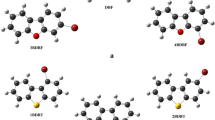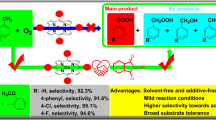Abstract
Ferrocene (Fc) as a non-benzene aromatic organometallic compound can undergo Friedel–Crafts acylation like benzene, but the two cyclopentadienes are symmetrically distributed in Fc, and both of them have the same ability of electrophilic substitution reaction, so the acetylation of ferrocene generally do not stop at mono-substitution, resulting in a mixture of acetylferrocene and diacetylferrocene. To obtain high content of acetylferrocene and diacetylferrocene respectively, density functional theory (DFT) calculations were performed to find the distinction of rate-determining activation step and determine the optimum reaction conditions based on a consecutive reaction mechanism and AlCl3 as the catalyst and the acetylchloride as acylating reagent. The results revealed that the rate determining barrier of the mono- and disubstitution overall reactions were very close, just 19.28 and 20.09 kcal/mol, respectively, meaning that disubstitution reaction may accompany monosubstitution reaction at the same conditions. The results of TST show that it is easier to get the higher yield of diacetylferrocene above 298.15 K, while the concentration of acetylferrocene is much higher than that of diacetylferrocene below 273.15 K, which inspire us to get an effective synthesis strategy of acetylferrocene and diacetylferrocene, respectively. The experimental results show that the optimum reaction conditions of acetylferrocene are the temperature, 273.15 K, the material ratio, nferrocene : nacetylchloride : \({{n}_{{{\text{AlC}}{{{\text{l}}}_{{\text{3}}}}}}}\) = 1.0 : 1.0 : 1.0. For diacetylferrocene, the optimum conditions are 298.15 K, as the corresponding ratios are 1.0 : 2.2 : 2.2.






Similar content being viewed by others
REFERENCES
R. W. Heo, J.-S. Park, and T. Randall Lee, Macromolecules 38, 2566 (2005).
S. A. Merchant,T. O. Tran, M. T. Meredith, T. C. Cline, D. T. Glatzhofer, and D. W. Schmidtke, Langmuir 25, 7736 (2009).
I. Hod, W. Bury, D. M. Gardner, P. Deria, O. K. Farha, and J. T. Hupp, J. Phys. Chem. Lett. 6, 586 (2015).
S. Yamabe and S. Yamazaki, J. Phys. Org. Chem. 22, 1094 (2009).
M. J. Frisch et al., Gaussian 09 (Gaussian, Inc., Wallingford, CT, 2009).
A. D. Becke, J. Chem. Phys. 98, 5648 (1993).
C. T. Lee, W. T. Yang, and R. G. Parr, Phys. Rev. B 37, 785 (1988).
C. Gonzalez and H. B. Schlegel, J. Phys. Chem. 94, 5523 (1990).
S. Canneaux, F. Bohr, and E. Henon, J. Comput. Chem. 35, 82 (2014).
D. W. Ball, J. Chem. Educ. 75, 917 (1998).
D. Kim, B.-k. Kim, Y. Cho, M. Han, and B.-S. Kim, Ind. Eng. Chem. Res. 48, 6591 (2009).
ACKNOWLEDGMENTS
The authors would like to acknowledge the Science, Technology and Innovation Commission of Shenzhen Municipality (JCYJ 20170306161133420), Supported by High Performance Computing Center of NPU of Northwestern Polytechnical University and Instrumental Analysis Center of the Chemical engineering institute, the Yulin University.
Author information
Authors and Affiliations
Corresponding author
Supplementary Information
Rights and permissions
About this article
Cite this article
Liu, X., Ma, X., Feng, H. et al. Theoretical Simulation and Experimental Optimization of Reaction Conditions and Product Composition of Ferrocene Acylation. Russ. J. Phys. Chem. 95 (Suppl 2), S252–S258 (2021). https://doi.org/10.1134/S0036024421150164
Received:
Revised:
Accepted:
Published:
Issue Date:
DOI: https://doi.org/10.1134/S0036024421150164




